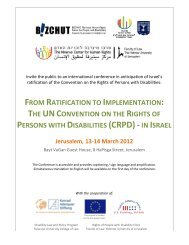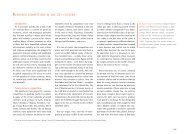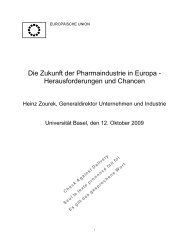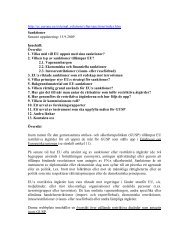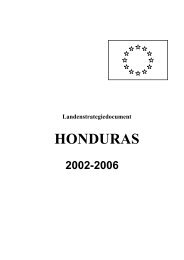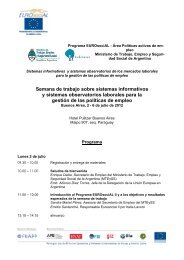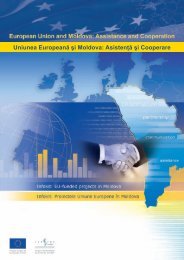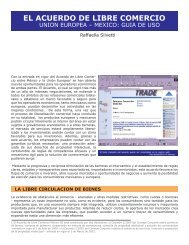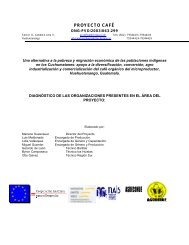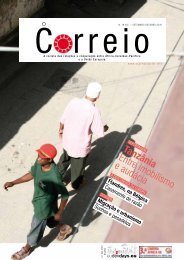Regional Reports - the European External Action Service
Regional Reports - the European External Action Service
Regional Reports - the European External Action Service
Create successful ePaper yourself
Turn your PDF publications into a flip-book with our unique Google optimized e-Paper software.
of 15-49 which indicates that <strong>the</strong> active age population is highly affected by <strong>the</strong> epidemic<br />
of HIV/Aids) a high level of civic engagement is found in <strong>the</strong> town;<br />
• According to disaster vulnerability assessment report of <strong>the</strong> Disaster Prevention and Food<br />
Security office of DDA, more than 48,275 people in rural Dire Dawa are identified to be<br />
chronically food insecure and ano<strong>the</strong>r 60,000 people are acutely affected in bad<br />
production years. A complex combination of factors has contributed to <strong>the</strong> alarming<br />
increase of rural food shortage vulnerability;<br />
• Socially Marginalized Groups basically include individuals or households who are street<br />
children, street prostitutes, beggars, disabled, and those poor households, which are<br />
potentially at risk, or are <strong>the</strong> hosts where socially marginalized groups come from.<br />
Studies conducted in this area indicate that inability of families to meet basic needs (food,<br />
clothing shelter) of <strong>the</strong>ir family members followed by loss of parents, which account for<br />
76% and 12% respectively, are <strong>the</strong> two most important factors compelling <strong>the</strong>ir members<br />
to start socially unacceptable ways of life i.e. Prostitution, beggary and “streetism”.<br />
Delinquent behaviour, lack of employment opportunity and substance addiction were also<br />
identified as factors contributing to <strong>the</strong> process of social marginalization;<br />
• Informal settlement in Dire Dawa town trace back to <strong>the</strong> year 1930,s and increased at an<br />
alarming rate from <strong>the</strong> beginning of 1950's up to <strong>the</strong> middle of 1960,s where <strong>the</strong> number<br />
of informal settlement escalated to about 6159;<br />
• According to a CSA report, an estimated number of 84,725 youths (15 - 29 of age) live in<br />
Dire Dawa accounting 31.6% of <strong>the</strong> total population. It is also observed that, <strong>the</strong> lion<br />
share of <strong>the</strong> youths (51.5%) are females which are about 43,618 in number and accounts<br />
for 16% of <strong>the</strong> total population;<br />
• Like o<strong>the</strong>r urban areas of <strong>the</strong> country, <strong>the</strong> major problem related to <strong>the</strong> youth in Dire<br />
Dawa is basically unemployment. According to CSA report on Urban Bi-Annual<br />
Employment Unemployment Survey, 54 percent of <strong>the</strong> total unemployed people are<br />
youths. The o<strong>the</strong>r major problem of <strong>the</strong> youth, is <strong>the</strong> epidemic of HIV/AIDS;<br />
• Tremendous progress had been made in <strong>the</strong> education sector of Dire Dawa<br />
Administration since <strong>the</strong> new Education and Training policies of <strong>the</strong> country were put in<br />
place in 1994. However, <strong>the</strong> existence low Gross & Net Enrolment Rate, a wide gender<br />
gap and wide location disparity indicate <strong>the</strong> overwhelming amount of work remains to be<br />
done to achieve Universal Primary Education (UPE) targets. It is also observed that <strong>the</strong>re<br />
is very low level of enrolment in grade one at <strong>the</strong> appropriate age (i.e. at age 7). Since <strong>the</strong><br />
level of enrolment in grade one is a decisive factor in achieving UPE as well as for<br />
minimizing <strong>the</strong> gender and location gaps, attention has to be given to it in order to<br />
maximize <strong>the</strong> apparent intake rate and to reduce <strong>the</strong> gender gap in both locations. Thus, it<br />
needs great effort and commitment to bring <strong>the</strong> rate to a higher level so as to catch up<br />
with <strong>the</strong> target of UPE, which presupposes that <strong>the</strong> Net intake Rate level should reach<br />
100%;<br />
• All <strong>the</strong> rural areas of <strong>the</strong> Administration are accessed by ei<strong>the</strong>r all - wea<strong>the</strong>r or drywea<strong>the</strong>r<br />
roads. The all - wea<strong>the</strong>r RR50 standard road branching from <strong>the</strong> Dire Dawa -<br />
Harar road is running east to Belewa for 43km and to <strong>the</strong> east to Lege-odagununfeta for<br />
35km. However ,<strong>the</strong> construction of <strong>the</strong> Lege-oda 35km road was suspended after<br />
covering a distances of about 14km. Dry-wea<strong>the</strong>r roads having a width of 4m have also<br />
been constructed using <strong>the</strong> income generating schemes (IGS) in various rural parts of <strong>the</strong><br />
47




